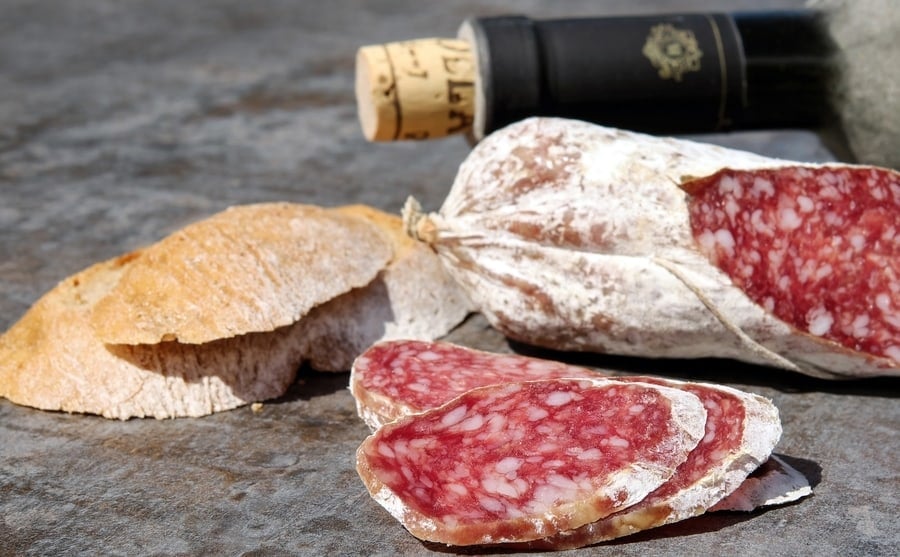Over the years I’ve built a tight, well-used library of meat-curing books I keep coming back to. These aren’t coffee-table flick-throughs; they’re dog‑eared, note‑filled references that shaped how I dry cure, smoke, and teach the craft on this site.
Below are the titles that actually moved the needle for me—clear, reliable, and grounded in real technique.
Which Book Should You Choose? Quick Comparison
At-a-Glance Comparison
| Book | Focus | Reading Style | Best For | Key Strength | Consider |
|---|---|---|---|---|---|
| Salumi (Ruhlman & Polcyn) | Italian whole-muscle cures & salami | Practical with a dose of inspiration | Beginners to intermediate seeking authentic Italian methods | Demystifies regional tradition into steps you can use | Not a deep technical encyclopedia |
| Home Production of Quality Meats & Sausages (Marianski) | Technical depth across curing & sausage | Methodical, science-driven | Intermediate to advanced; precision & repeatability | Clear process control, safety logic, troubleshooting | Dense; fewer photos, more process |
| The River Cottage Curing & Smoking Handbook (Lamb) | Well-rounded curing & smoking with recipes | Warm, instructional, story-led | Cooks who want fundamentals plus creativity | Bridges technique and everyday cooking | Less granular than Marianski on technicals |
Meat-Curing & Smoking Books You’ll Return to Again and Again
Each book here covers the same fundamentals—salt, time, airflow, and temperature—but with a different lens. One leans poetic and regional (Italy), one is a technical encyclopedia (Polish precision), and one blends method with story (English, with Mediterranean influence). Together they give you the “why,” the “how,” and the creative spark to keep going.

Salumi: The Craft of Italian Dry Curing (Michael Ruhlman & Brian Polcyn)
What You’ll Learn
A clear, inviting entry to Italian whole‑muscle curing and salami. It breaks down regional traditions into practical steps, from selecting and trimming the classic muscles to timing, salting, and drying. There’s enough detail to get started and enough soul to keep you motivated.
- Italian method for breaking down a side of pork into curing muscles
- Eight cornerstone whole‑muscle cures plus core salami styles
- Foundational technique explained in approachable language
- Cooking ideas that showcase your cured meats
Ideal For…
Curious beginners and intermediate home curers who want inspiration with solid fundamentals. If you’re drawn to classic Italian salumi and want a confident, get‑started framework, this is it.
Home Production of Quality Meats & Sausages (Stanley & Adam Marianski)
Scope & Depth
Think “encyclopedia of curing and sausage.” It’s rigorous and technical in the best way: process control, safety logic, smoke application, and methodical workflows. When I need to sanity‑check a ratio, airflow window, or process nuance—this is the book I reach for.
- Fresh, emulsified, and dry‑cured sausage processes end‑to‑end
- Science of salt diffusion, water activity, and smoke
- Hot and cold smoking techniques with equipment options
- Troubleshooting guidance that actually fixes problems
Ideal For…
Intermediate to advanced home curers who want repeatable results and a deeper understanding of the mechanics. Less glossy photos, more real answers.
The River Cottage Curing & Smoking Handbook (Steven Lamb)
Tone & Style
Warm, practical, and grounded, with a British voice and Mediterranean accents. It covers the fundamentals properly, then nudges you toward flavor exploration and seasonal thinking. It reads like learning beside an experienced friend who actually cooks this stuff every week.
- Core techniques for curing meats and fish
- Accessible guidance with solid, real‑world context
- Recipe ideas that encourage experimentation
- Balanced blend of method and inspiration
Ideal For…
Cooks who value reliable method but want a push toward creativity. Great companion to the more technical titles above.
Quick note: the internet is flooded with curing “shortcuts” that skip fundamentals. These books respect the craft—technique first, then creativity—so you learn the right way and build confidence as you go.
One of the reasons I recommend Salumi so often is the way it bridges tradition and accessibility. Italian dry curing has an almost endless variety of regional techniques—sometimes shifting from town to town—and this book distills those differences into a method you can use at home. Once you’ve learned the dry curing fundamentals, it becomes much easier to adapt the recipes to your own climate, tools, and tastes.
Ruhlman & Polcyn’s earlier book, Charcuterie, focuses more on the French canon, with pâtés, rillettes, and confit alongside an introduction to whole muscle curing. If you want to explore cooked charcuterie as well as cured meats, it’s a great companion to Salumi.

If you lean toward Italian traditions and want to understand why certain cuts and salting styles matter, start with the Italian perspective, then deep-dive the science. For context on craftsmanship and heritage, see why Prosciutto di Parma is special—it frames what “good” looks like when you aim for classic results.
More Books That Inspire Curing & Smoking Creativity
For creative flavor ideas beyond the European canon, Diana Henry’s Salt, Sugar, Smoke is a great companion. It’s not a technical curing manual, but it will widen your pantry and spark combinations you might not try otherwise—useful once your core method is dialed in.
Expert Tip
Start with one whole-muscle cure (like bresaola or lonza) and run it end-to-end using the same notebook for ratios, dates, weights (before/after), and chamber conditions. Repeat the same project twice before changing anything. This isolates variables and builds reliable “muscle memory” for your specific environment.
Have a question or a book you think belongs on this list? Drop it in the comments — I read every one and I’m always keen to test new resources.

Tom Mueller
For decades, immersed in studying, working, learning, and teaching the craft of meat curing, sharing the passion and showcasing the world of charcuterie and smoked meat. Read More
